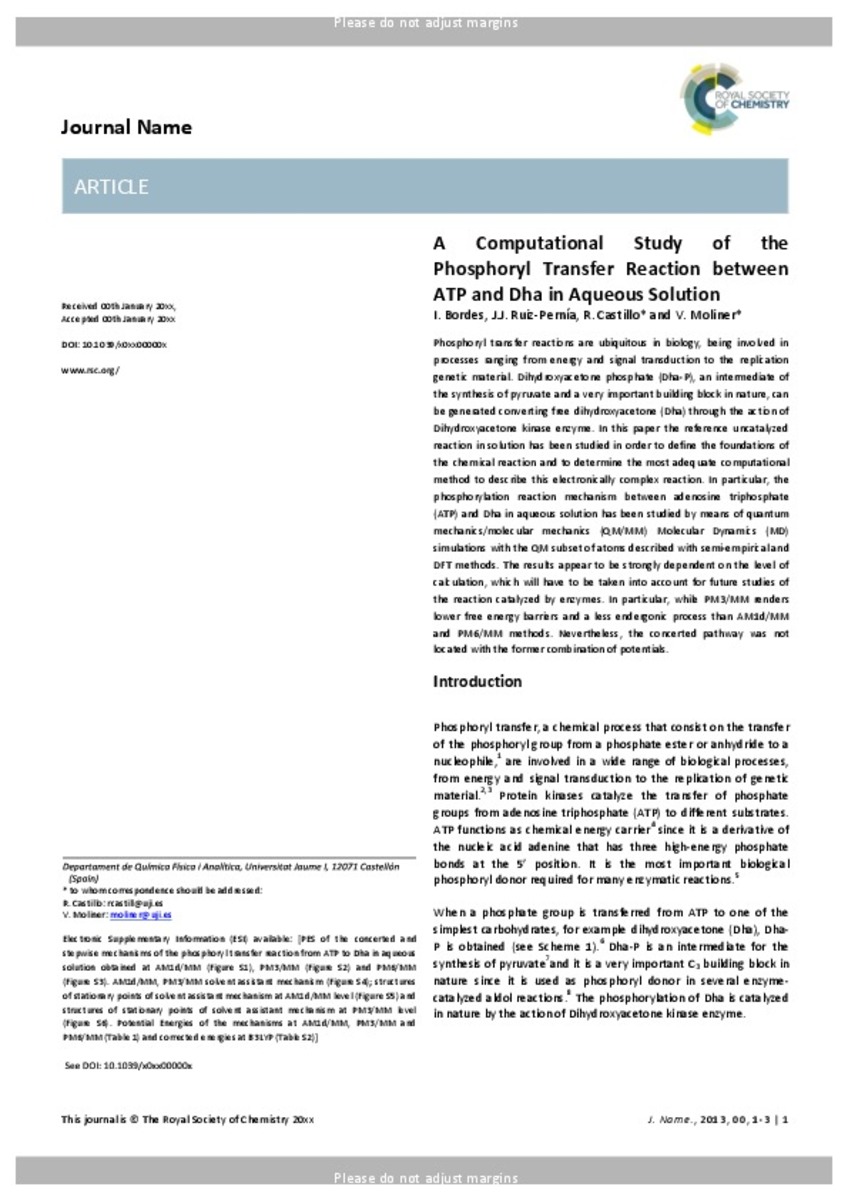Mostrar el registro sencillo del ítem
A computational study of the phosphoryl transfer reaction between ATP and Dha in Aqueous Solution
| dc.contributor.author | Bordes, Isabel | |
| dc.contributor.author | Ruiz-Pernía, José Javier | |
| dc.contributor.author | Castillo, Raquel | |
| dc.contributor.author | Moliner, Vicent | |
| dc.date.accessioned | 2016-02-23T12:13:51Z | |
| dc.date.available | 2016-02-23T12:13:51Z | |
| dc.date.issued | 2015 | |
| dc.identifier.citation | Organic & Biomolecular Chemistry, 2015, 13, 10179 | ca_CA |
| dc.identifier.issn | 1477-0520 | |
| dc.identifier.issn | 1477-0539 | |
| dc.identifier.uri | http://hdl.handle.net/10234/151365 | |
| dc.description.abstract | Phosphoryl transfer reactions are ubiquitous in biology, being involved in processes ranging from energy and signal transduction to the replication genetic material. Dihydroxyacetone phosphate (Dha-P), an intermediate of the synthesis of pyruvate and a very important building block in nature, can be generated by converting free dihydroxyacetone (Dha) through the action of the dihydroxyacetone kinase enzyme. In this paper the reference uncatalyzed reaction in solution has been studied in order to define the foundations of the chemical reaction and to determine the most adequate computational method to describe this electronically complex reaction. In particular, the phosphorylation reaction mechanism between adenosine triphosphate (ATP) and Dha in aqueous solution has been studied by means of quantum mechanics/molecular mechanics (QM/MM) Molecular Dynamics (MD) simulations with the QM subset of atoms described with semi-empirical and DFT methods. The results appear to be strongly dependent on the level of calculation, which will have to be taken into account for future studies of the reaction catalyzed by enzymes. In particular, PM3/MM renders lower free energy barriers and a less endergonic process than AM1d/MM and PM6/MM methods. Nevertheless, the concerted pathway was not located with the former combination of potentials. | ca_CA |
| dc.description.sponsorShip | Spanish Ministerio de Economia y Competitividad. CTQ2012-36253-C03-01 Generalitat Valenciana. II/2014/022 Universitat Jaume I. P1 1B2013-58 | ca_CA |
| dc.format.extent | 12 p. | ca_CA |
| dc.format.mimetype | application/pdf | ca_CA |
| dc.language.iso | eng | ca_CA |
| dc.publisher | Royal Society of Chemistry | ca_CA |
| dc.relation.isPartOf | Org. Biomol. Chem., 2015, 13 | ca_CA |
| dc.rights | This journal is © The Royal Society of Chemistry 2015 | ca_CA |
| dc.rights.uri | http://rightsstatements.org/vocab/InC/1.0/ | * |
| dc.subject | Phosphate monoester hydrolysis | ca_CA |
| dc.subject | dihydroxyacetone kinases | ca_CA |
| dc.subject | Molecular simulations | ca_CA |
| dc.subject | Semiempirical methods | ca_CA |
| dc.subject | Computer-simulations | ca_CA |
| dc.subject | Alkaline-Phosphatase | ca_CA |
| dc.subject | Dynamics simulations | ca_CA |
| dc.subject | Potential functions | ca_CA |
| dc.subject | Energy surfaces | ca_CA |
| dc.subject | Mechanism | ca_CA |
| dc.title | A computational study of the phosphoryl transfer reaction between ATP and Dha in Aqueous Solution | ca_CA |
| dc.type | info:eu-repo/semantics/article | ca_CA |
| dc.identifier.doi | http://dx.doi.org/10.1039/c5ob01079a | |
| dc.rights.accessRights | info:eu-repo/semantics/openAccess | ca_CA |
| dc.relation.publisherVersion | http://pubs.rsc.org/En/content/articlepdf/2015/ob/c5ob01079a | ca_CA |
| dc.type.version | info:eu-repo/semantics/acceptedVersion | ca_CA |
Ficheros en el ítem
Este ítem aparece en la(s) siguiente(s) colección(ones)
-
QFA_Articles [819]
Articles de publicacions periòdiques







